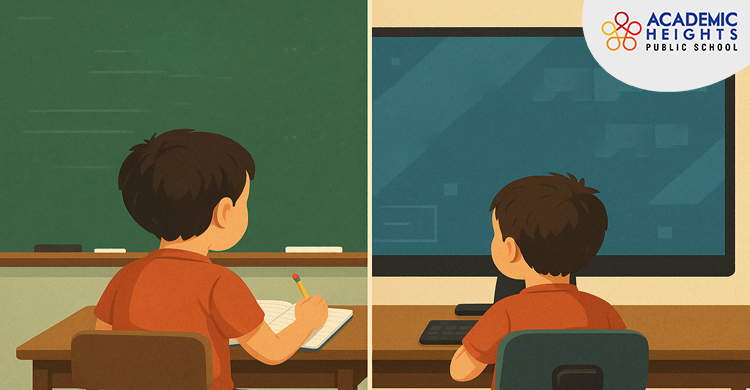We are all living in an era where everything is digital—from online shopping to online education. The profound impact of the digital revolution on education has enabled students from all around the world to access education from any corner of the world. With the invention of advanced technologies like Virtual Reality (VR), Augmented Reality (AR), and gamification, the education method has become cutting-edge as well as flexible for the students. This blog discusses the benefits and drawbacks of digital technology in education.
Evolution of Education: From Chalkboards to Digital Classrooms

The classrooms have good old chalkboards and students take notes and memorise, and that is it. Then, boom! The emergence of digital classrooms makes learning more interactive and engaging. Yes, that’s right. Students engage in interactive sessions through digital classrooms. They can see and comment on their favourite tutorials, as well as take part in live quizzes. Also, audiovisual aids such as animation and play sounds make complex concepts easier to understand.
Benefits of the Digital Revolution in Education

The role of digital technology in education comes with lots of benefits for the students. Below, we’ll outline a few of the advantages.
- Personalised learning: Smart apps and software have a variety of topics from which the students can choose their preferred ones to learn about. The best part is that the students can now learn at their own pace. They can start, pause, and resume the videos whenever they want.
- Globalisation of the Classroom: Video calls such as Zoom and Google Meet have made it possible for students across the world to stay connected globally. International courses are also available to them via online learning environments like Coursera and Udemy.
- Collaborative Learning: Students no longer have to learn alone. Thanks to digital technology, even if they live in different parts of the world, they can still share their ideas with other people! By connecting with various people, young learners develop their teamwork abilities and communication skills while also boosting their confidence.
Challenges of the Digital Revolution in Education

- Cybersecurity and Privacy Concerns: Digital technology gathers a lot of data, including students’ personal information and academic records. Hackers or strangers might obtain such information and exploit it for their gain.
- Teacher Training and Adaptation: Teachers who are used to traditional ways of teaching find it difficult to adapt to digital methods of teaching. They become resistant to this shift, which hinders their ability to learn. Additionally, some educational institutions also fail to provide adequate training for digital tools to teachers who wish to adapt.
- Over-reliance on Technology: Digital technology in education is beneficial as long as it doesn’t hamper cognitive skills. Over-reliance on technology may restrict students’ creative thinking and problem-solving abilities. Therefore, finding a balance between technology and traditional methods of teaching becomes essential.
The Future of Education in a Digital World

The role of digital technology in education has made learning faster and smarter for students. It has the potential to greatly reduce the cultural and language barriers with its interactive and easy-to-access attributes. While the future of education will be significantly shaped by technology, a new generation of teachers will be needed who will recognise the value of human interactions in the classroom to make sure that new teaching resources are used effectively.
Conclusion:-
Digital education is a powerful tool for students to sharpen their global understanding and cultural awareness. The impact of the digital revolution on education has turned out to be transformative. Gone are the days when students had to be dependent on only textbooks and teacher notes. They can use various educational apps to learn, and that too at their convenience. But it’s important to keep in mind that digital technology shouldn’t be relied upon excessively. At AHPS, students are taught using a blend of traditional and digital teaching methods.
